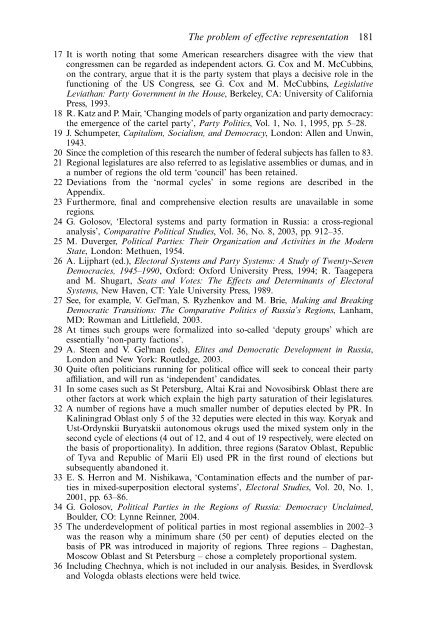Federalism and Local Politics in Russia
Federalism and Local Politics in Russia
Federalism and Local Politics in Russia
You also want an ePaper? Increase the reach of your titles
YUMPU automatically turns print PDFs into web optimized ePapers that Google loves.
The problem of effective representation 18117 It is worth not<strong>in</strong>g that some American researchers disagree with the view thatcongressmen can be regarded as <strong>in</strong>dependent actors. G. Cox <strong>and</strong> M. McCubb<strong>in</strong>s,on the contrary, argue that it is the party system that plays a decisive role <strong>in</strong> thefunction<strong>in</strong>g of the US Congress, see G. Cox <strong>and</strong> M. McCubb<strong>in</strong>s, LegislativeLeviathan: Party Government <strong>in</strong> the House, Berkeley, CA: University of CaliforniaPress, 1993.18 R. Katz <strong>and</strong> P. Mair, ‘Chang<strong>in</strong>g models of party organization <strong>and</strong> party democracy:the emergence of the cartel party’, Party <strong>Politics</strong>, Vol. 1, No. 1, 1995, pp. 5–28.19 J. Schumpeter, Capitalism, Socialism, <strong>and</strong> Democracy, London: Allen <strong>and</strong> Unw<strong>in</strong>,1943.20 S<strong>in</strong>ce the completion of this research the number of federal subjects has fallen to 83.21 Regional legislatures are also referred to as legislative assemblies or dumas, <strong>and</strong> <strong>in</strong>a number of regions the old term ‘council’ has been reta<strong>in</strong>ed.22 Deviations from the ‘normal cycles’ <strong>in</strong> some regions are described <strong>in</strong> theAppendix.23 Furthermore, f<strong>in</strong>al <strong>and</strong> comprehensive election results are unavailable <strong>in</strong> someregions.24 G. Golosov, ‘Electoral systems <strong>and</strong> party formation <strong>in</strong> <strong>Russia</strong>: a cross-regionalanalysis’, Comparative Political Studies, Vol. 36, No. 8, 2003, pp. 912–35.25 M. Duverger, Political Parties: Their Organization <strong>and</strong> Activities <strong>in</strong> the ModernState, London: Methuen, 1954.26 A. Lijphart (ed.), Electoral Systems <strong>and</strong> Party Systems: A Study of Twenty-SevenDemocracies, 1945–1990, Oxford: Oxford University Press, 1994; R. Taagepera<strong>and</strong> M. Shugart, Seats <strong>and</strong> Votes: The Effects <strong>and</strong> Determ<strong>in</strong>ants of ElectoralSystems, New Haven, CT: Yale University Press, 1989.27 See, for example, V. Gel'man, S. Ryzhenkov <strong>and</strong> M. Brie, Mak<strong>in</strong>g <strong>and</strong> Break<strong>in</strong>gDemocratic Transitions: The Comparative <strong>Politics</strong> of <strong>Russia</strong>’s Regions, Lanham,MD: Rowman <strong>and</strong> Littlefield, 2003.28 At times such groups were formalized <strong>in</strong>to so-called ‘deputy groups’ which areessentially ‘non-party factions’.29 A. Steen <strong>and</strong> V. Gel'man (eds), Elites <strong>and</strong> Democratic Development <strong>in</strong> <strong>Russia</strong>,London <strong>and</strong> New York: Routledge, 2003.30 Quite often politicians runn<strong>in</strong>g for political office will seek to conceal their partyaffiliation, <strong>and</strong> will run as ‘<strong>in</strong>dependent’ c<strong>and</strong>idates.31 In some cases such as St Petersburg, Altai Krai <strong>and</strong> Novosibirsk Oblast there areother factors at work which expla<strong>in</strong> the high party saturation of their legislatures.32 A number of regions have a much smaller number of deputies elected by PR. InKal<strong>in</strong><strong>in</strong>grad Oblast only 5 of the 32 deputies were elected <strong>in</strong> this way. Koryak <strong>and</strong>Ust-Ordynskii Buryatskii autonomous okrugs used the mixed system only <strong>in</strong> thesecond cycle of elections (4 out of 12, <strong>and</strong> 4 out of 19 respectively, were elected onthe basis of proportionality). In addition, three regions (Saratov Oblast, Republicof Tyva <strong>and</strong> Republic of Marii El) used PR <strong>in</strong> the first round of elections butsubsequently ab<strong>and</strong>oned it.33 E. S. Herron <strong>and</strong> M. Nishikawa, ‘Contam<strong>in</strong>ation effects <strong>and</strong> the number of parties<strong>in</strong> mixed-superposition electoral systems’, Electoral Studies, Vol. 20, No. 1,2001, pp. 63–86.34 G. Golosov, Political Parties <strong>in</strong> the Regions of <strong>Russia</strong>: Democracy Unclaimed,Boulder, CO: Lynne Re<strong>in</strong>ner, 2004.35 The underdevelopment of political parties <strong>in</strong> most regional assemblies <strong>in</strong> 2002–3was the reason why a m<strong>in</strong>imum share (50 per cent) of deputies elected on thebasis of PR was <strong>in</strong>troduced <strong>in</strong> majority of regions. Three regions – Daghestan,Moscow Oblast <strong>and</strong> St Petersburg – chose a completely proportional system.36 Includ<strong>in</strong>g Chechnya, which is not <strong>in</strong>cluded <strong>in</strong> our analysis. Besides, <strong>in</strong> Sverdlovsk<strong>and</strong> Vologda oblasts elections were held twice.
















